Australian Commercial Law Assignment: Legal Principles Analysis
VerifiedAdded on 2021/05/31
|12
|2881
|35
Homework Assignment
AI Summary
This assignment solution addresses key aspects of Australian Commercial Law, specifically focusing on contract law principles, misrepresentation, and remedies for breach of contract. Part A analyzes H.L.A. Hart's rule of recognition within the Australian legal system, comparing it to the UK's system and highlighting the role of common law, statutory law, and customary law. Part B delves into a case study involving a contract for the sale of a business, examining issues of misrepresentation, counter-offers, and the validity of the agreement. The solution applies relevant legal principles and case precedents, such as Carlill v Carbolic Smoke Ball Company, Hyde v Wrench, and Pankhania v Hackney, to determine the contract's validity and the available remedies for the parties involved. The analysis concludes that the contract is void due to fraudulent misrepresentation and explores the remedies available to the aggrieved party, including damages and indemnity.
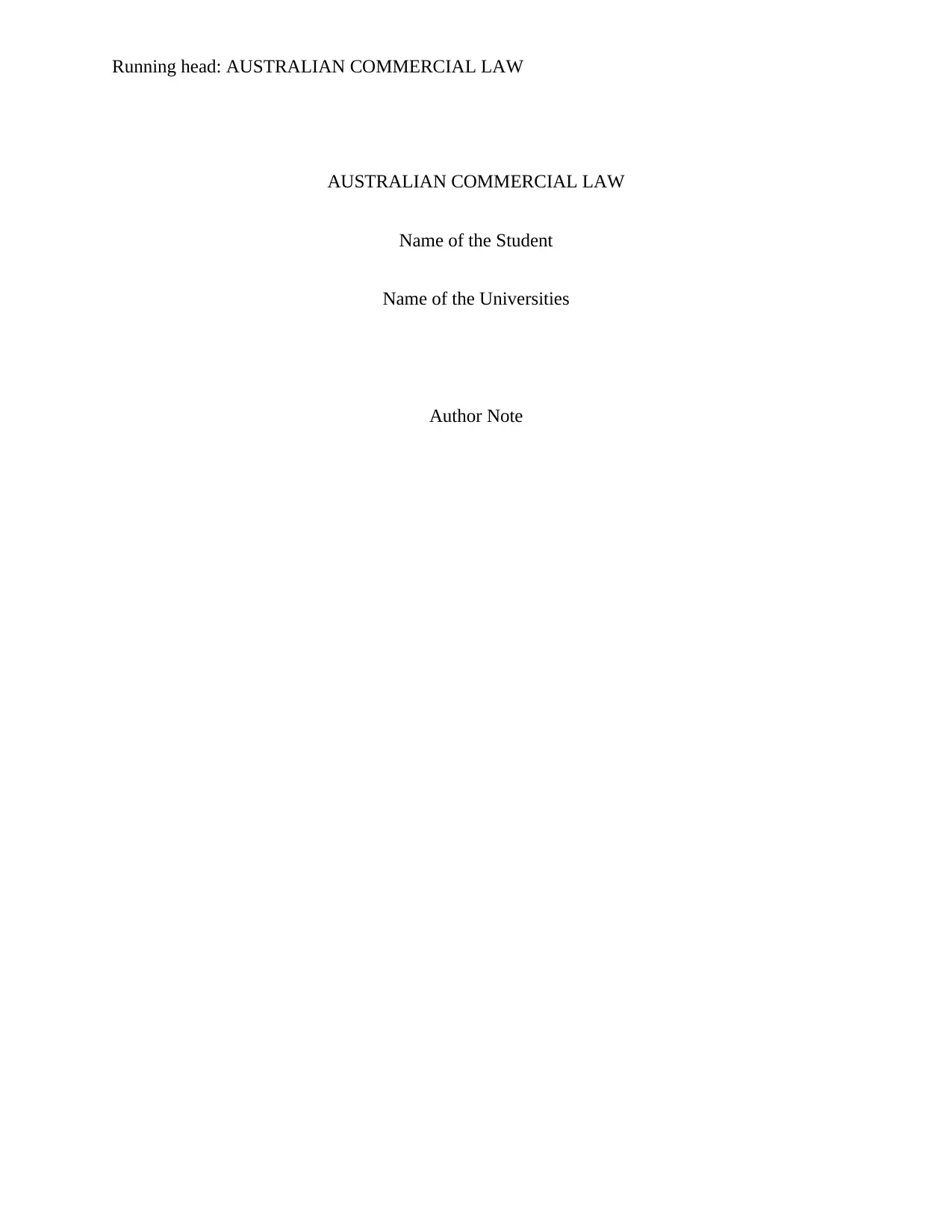
Running head: AUSTRALIAN COMMERCIAL LAW
AUSTRALIAN COMMERCIAL LAW
Name of the Student
Name of the Universities
Author Note
AUSTRALIAN COMMERCIAL LAW
Name of the Student
Name of the Universities
Author Note
Paraphrase This Document
Need a fresh take? Get an instant paraphrase of this document with our AI Paraphraser
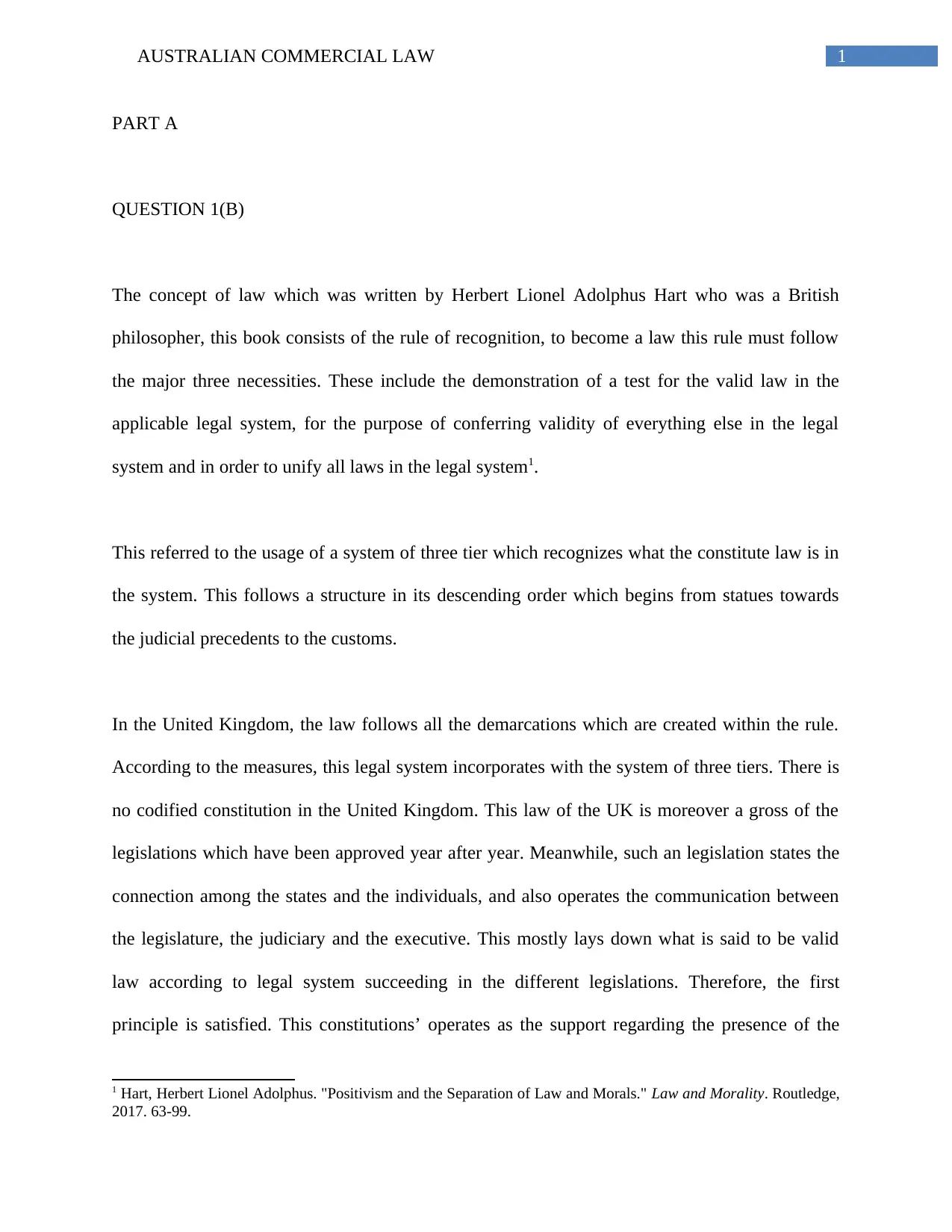
1AUSTRALIAN COMMERCIAL LAW
PART A
QUESTION 1(B)
The concept of law which was written by Herbert Lionel Adolphus Hart who was a British
philosopher, this book consists of the rule of recognition, to become a law this rule must follow
the major three necessities. These include the demonstration of a test for the valid law in the
applicable legal system, for the purpose of conferring validity of everything else in the legal
system and in order to unify all laws in the legal system1.
This referred to the usage of a system of three tier which recognizes what the constitute law is in
the system. This follows a structure in its descending order which begins from statues towards
the judicial precedents to the customs.
In the United Kingdom, the law follows all the demarcations which are created within the rule.
According to the measures, this legal system incorporates with the system of three tiers. There is
no codified constitution in the United Kingdom. This law of the UK is moreover a gross of the
legislations which have been approved year after year. Meanwhile, such an legislation states the
connection among the states and the individuals, and also operates the communication between
the legislature, the judiciary and the executive. This mostly lays down what is said to be valid
law according to legal system succeeding in the different legislations. Therefore, the first
principle is satisfied. This constitutions’ operates as the support regarding the presence of the
1 Hart, Herbert Lionel Adolphus. "Positivism and the Separation of Law and Morals." Law and Morality. Routledge,
2017. 63-99.
PART A
QUESTION 1(B)
The concept of law which was written by Herbert Lionel Adolphus Hart who was a British
philosopher, this book consists of the rule of recognition, to become a law this rule must follow
the major three necessities. These include the demonstration of a test for the valid law in the
applicable legal system, for the purpose of conferring validity of everything else in the legal
system and in order to unify all laws in the legal system1.
This referred to the usage of a system of three tier which recognizes what the constitute law is in
the system. This follows a structure in its descending order which begins from statues towards
the judicial precedents to the customs.
In the United Kingdom, the law follows all the demarcations which are created within the rule.
According to the measures, this legal system incorporates with the system of three tiers. There is
no codified constitution in the United Kingdom. This law of the UK is moreover a gross of the
legislations which have been approved year after year. Meanwhile, such an legislation states the
connection among the states and the individuals, and also operates the communication between
the legislature, the judiciary and the executive. This mostly lays down what is said to be valid
law according to legal system succeeding in the different legislations. Therefore, the first
principle is satisfied. This constitutions’ operates as the support regarding the presence of the
1 Hart, Herbert Lionel Adolphus. "Positivism and the Separation of Law and Morals." Law and Morality. Routledge,
2017. 63-99.
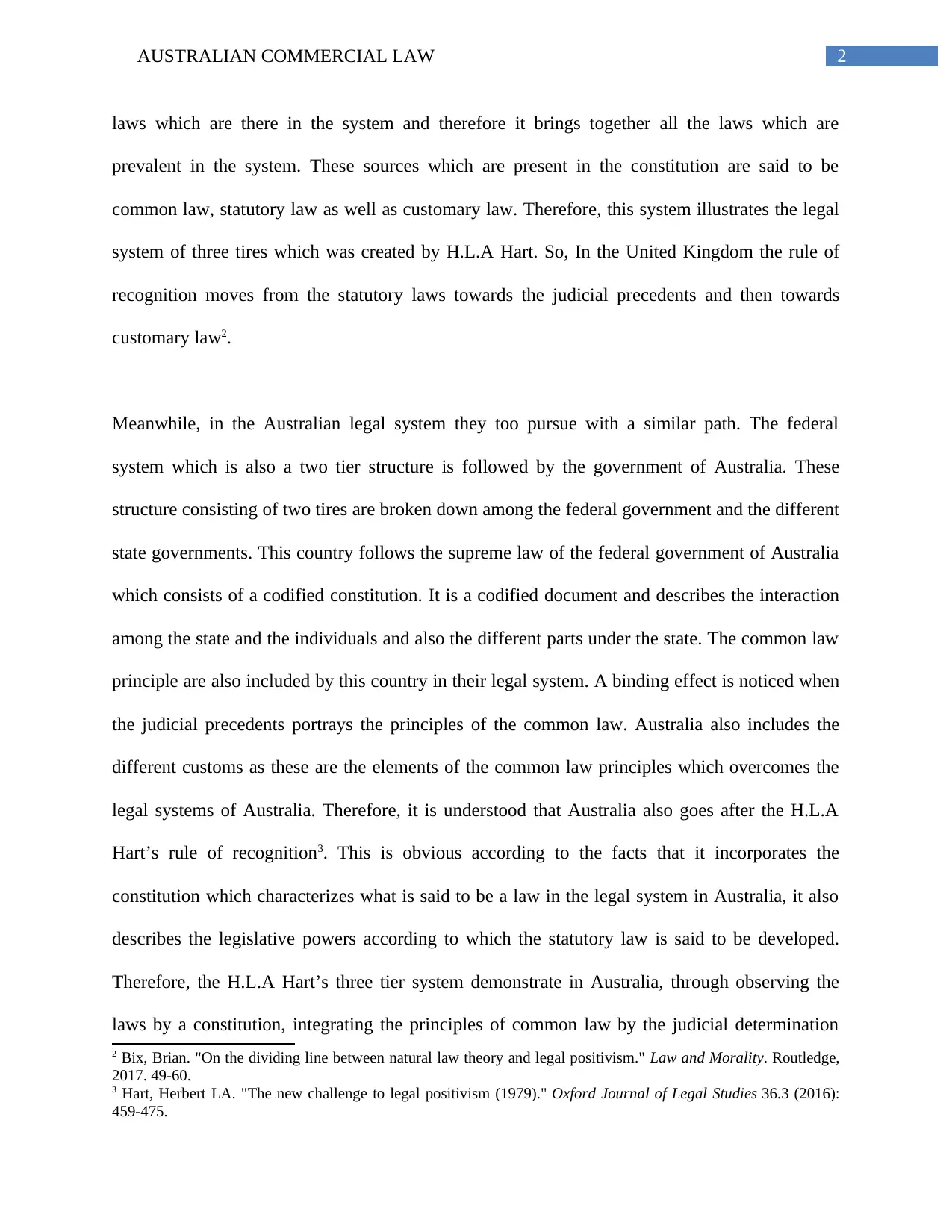
2AUSTRALIAN COMMERCIAL LAW
laws which are there in the system and therefore it brings together all the laws which are
prevalent in the system. These sources which are present in the constitution are said to be
common law, statutory law as well as customary law. Therefore, this system illustrates the legal
system of three tires which was created by H.L.A Hart. So, In the United Kingdom the rule of
recognition moves from the statutory laws towards the judicial precedents and then towards
customary law2.
Meanwhile, in the Australian legal system they too pursue with a similar path. The federal
system which is also a two tier structure is followed by the government of Australia. These
structure consisting of two tires are broken down among the federal government and the different
state governments. This country follows the supreme law of the federal government of Australia
which consists of a codified constitution. It is a codified document and describes the interaction
among the state and the individuals and also the different parts under the state. The common law
principle are also included by this country in their legal system. A binding effect is noticed when
the judicial precedents portrays the principles of the common law. Australia also includes the
different customs as these are the elements of the common law principles which overcomes the
legal systems of Australia. Therefore, it is understood that Australia also goes after the H.L.A
Hart’s rule of recognition3. This is obvious according to the facts that it incorporates the
constitution which characterizes what is said to be a law in the legal system in Australia, it also
describes the legislative powers according to which the statutory law is said to be developed.
Therefore, the H.L.A Hart’s three tier system demonstrate in Australia, through observing the
laws by a constitution, integrating the principles of common law by the judicial determination
2 Bix, Brian. "On the dividing line between natural law theory and legal positivism." Law and Morality. Routledge,
2017. 49-60.
3 Hart, Herbert LA. "The new challenge to legal positivism (1979)." Oxford Journal of Legal Studies 36.3 (2016):
459-475.
laws which are there in the system and therefore it brings together all the laws which are
prevalent in the system. These sources which are present in the constitution are said to be
common law, statutory law as well as customary law. Therefore, this system illustrates the legal
system of three tires which was created by H.L.A Hart. So, In the United Kingdom the rule of
recognition moves from the statutory laws towards the judicial precedents and then towards
customary law2.
Meanwhile, in the Australian legal system they too pursue with a similar path. The federal
system which is also a two tier structure is followed by the government of Australia. These
structure consisting of two tires are broken down among the federal government and the different
state governments. This country follows the supreme law of the federal government of Australia
which consists of a codified constitution. It is a codified document and describes the interaction
among the state and the individuals and also the different parts under the state. The common law
principle are also included by this country in their legal system. A binding effect is noticed when
the judicial precedents portrays the principles of the common law. Australia also includes the
different customs as these are the elements of the common law principles which overcomes the
legal systems of Australia. Therefore, it is understood that Australia also goes after the H.L.A
Hart’s rule of recognition3. This is obvious according to the facts that it incorporates the
constitution which characterizes what is said to be a law in the legal system in Australia, it also
describes the legislative powers according to which the statutory law is said to be developed.
Therefore, the H.L.A Hart’s three tier system demonstrate in Australia, through observing the
laws by a constitution, integrating the principles of common law by the judicial determination
2 Bix, Brian. "On the dividing line between natural law theory and legal positivism." Law and Morality. Routledge,
2017. 49-60.
3 Hart, Herbert LA. "The new challenge to legal positivism (1979)." Oxford Journal of Legal Studies 36.3 (2016):
459-475.
⊘ This is a preview!⊘
Do you want full access?
Subscribe today to unlock all pages.

Trusted by 1+ million students worldwide

3AUSTRALIAN COMMERCIAL LAW
and integrating the customary law as well. Such a legal system in this country is compared to that
of the legal system of the United Kingdom, as the two incorporates with the three tier rule of
H.L.A Hart. The clearly visible difference among these two systems is that an unwritten
constitution is applied by the United Kingdom, this constitution is a bunch of legislations which
can regulate as well as define the constitutional provisions, it gives much more space to the
common law for clarifying the circumstances and hence there is broader opportunity for
recognizing the law. Meanwhile, Australia is having a codified law and therefore they have
better overview of what is recognized as law. It means that the principles of the common law
acquire a limited scope of incorporation, the judicial decisions will not be having any binding
effect in relation to the codified provisions. Therefore, it will also be followed that such limited
scope of recognition will be having more characterized test regarding the laws, and lesser
capacity for the subjective interpretations4.
PART B
QUESTION 2
RELATIVE ISSUE
A contract was made between Angelo and Barry regarding the purchase of the vegetable and
fruit store. This shop was said to be a extremely beneficial enterprise which had an income
amounting to $20,000 monthly, and their were no such competitors present this statement was
4 Cotterrell, Roger. Law, culture and society: Legal ideas in the mirror of social theory. Routledge, 2017.
and integrating the customary law as well. Such a legal system in this country is compared to that
of the legal system of the United Kingdom, as the two incorporates with the three tier rule of
H.L.A Hart. The clearly visible difference among these two systems is that an unwritten
constitution is applied by the United Kingdom, this constitution is a bunch of legislations which
can regulate as well as define the constitutional provisions, it gives much more space to the
common law for clarifying the circumstances and hence there is broader opportunity for
recognizing the law. Meanwhile, Australia is having a codified law and therefore they have
better overview of what is recognized as law. It means that the principles of the common law
acquire a limited scope of incorporation, the judicial decisions will not be having any binding
effect in relation to the codified provisions. Therefore, it will also be followed that such limited
scope of recognition will be having more characterized test regarding the laws, and lesser
capacity for the subjective interpretations4.
PART B
QUESTION 2
RELATIVE ISSUE
A contract was made between Angelo and Barry regarding the purchase of the vegetable and
fruit store. This shop was said to be a extremely beneficial enterprise which had an income
amounting to $20,000 monthly, and their were no such competitors present this statement was
4 Cotterrell, Roger. Law, culture and society: Legal ideas in the mirror of social theory. Routledge, 2017.
Paraphrase This Document
Need a fresh take? Get an instant paraphrase of this document with our AI Paraphraser
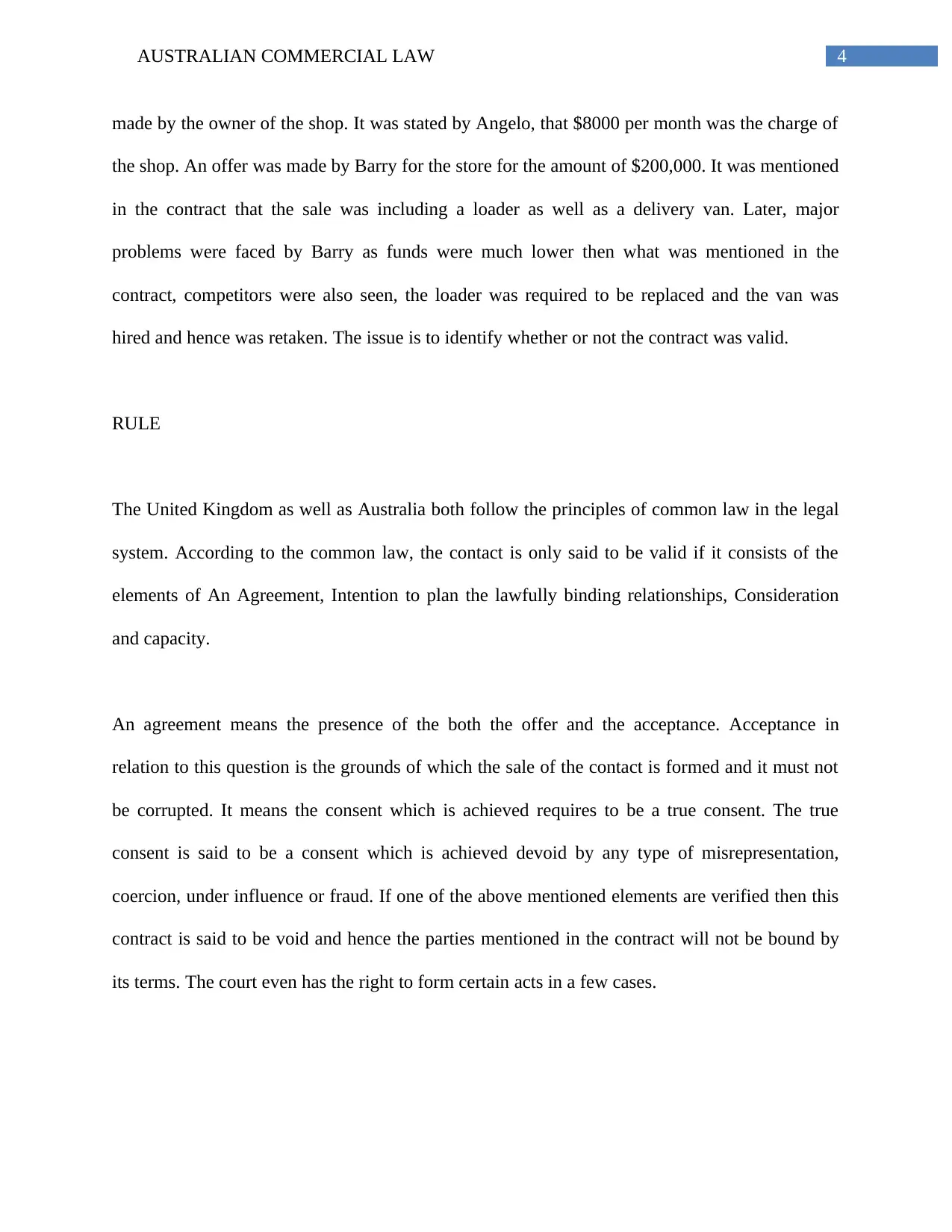
4AUSTRALIAN COMMERCIAL LAW
made by the owner of the shop. It was stated by Angelo, that $8000 per month was the charge of
the shop. An offer was made by Barry for the store for the amount of $200,000. It was mentioned
in the contract that the sale was including a loader as well as a delivery van. Later, major
problems were faced by Barry as funds were much lower then what was mentioned in the
contract, competitors were also seen, the loader was required to be replaced and the van was
hired and hence was retaken. The issue is to identify whether or not the contract was valid.
RULE
The United Kingdom as well as Australia both follow the principles of common law in the legal
system. According to the common law, the contact is only said to be valid if it consists of the
elements of An Agreement, Intention to plan the lawfully binding relationships, Consideration
and capacity.
An agreement means the presence of the both the offer and the acceptance. Acceptance in
relation to this question is the grounds of which the sale of the contact is formed and it must not
be corrupted. It means the consent which is achieved requires to be a true consent. The true
consent is said to be a consent which is achieved devoid by any type of misrepresentation,
coercion, under influence or fraud. If one of the above mentioned elements are verified then this
contract is said to be void and hence the parties mentioned in the contract will not be bound by
its terms. The court even has the right to form certain acts in a few cases.
made by the owner of the shop. It was stated by Angelo, that $8000 per month was the charge of
the shop. An offer was made by Barry for the store for the amount of $200,000. It was mentioned
in the contract that the sale was including a loader as well as a delivery van. Later, major
problems were faced by Barry as funds were much lower then what was mentioned in the
contract, competitors were also seen, the loader was required to be replaced and the van was
hired and hence was retaken. The issue is to identify whether or not the contract was valid.
RULE
The United Kingdom as well as Australia both follow the principles of common law in the legal
system. According to the common law, the contact is only said to be valid if it consists of the
elements of An Agreement, Intention to plan the lawfully binding relationships, Consideration
and capacity.
An agreement means the presence of the both the offer and the acceptance. Acceptance in
relation to this question is the grounds of which the sale of the contact is formed and it must not
be corrupted. It means the consent which is achieved requires to be a true consent. The true
consent is said to be a consent which is achieved devoid by any type of misrepresentation,
coercion, under influence or fraud. If one of the above mentioned elements are verified then this
contract is said to be void and hence the parties mentioned in the contract will not be bound by
its terms. The court even has the right to form certain acts in a few cases.
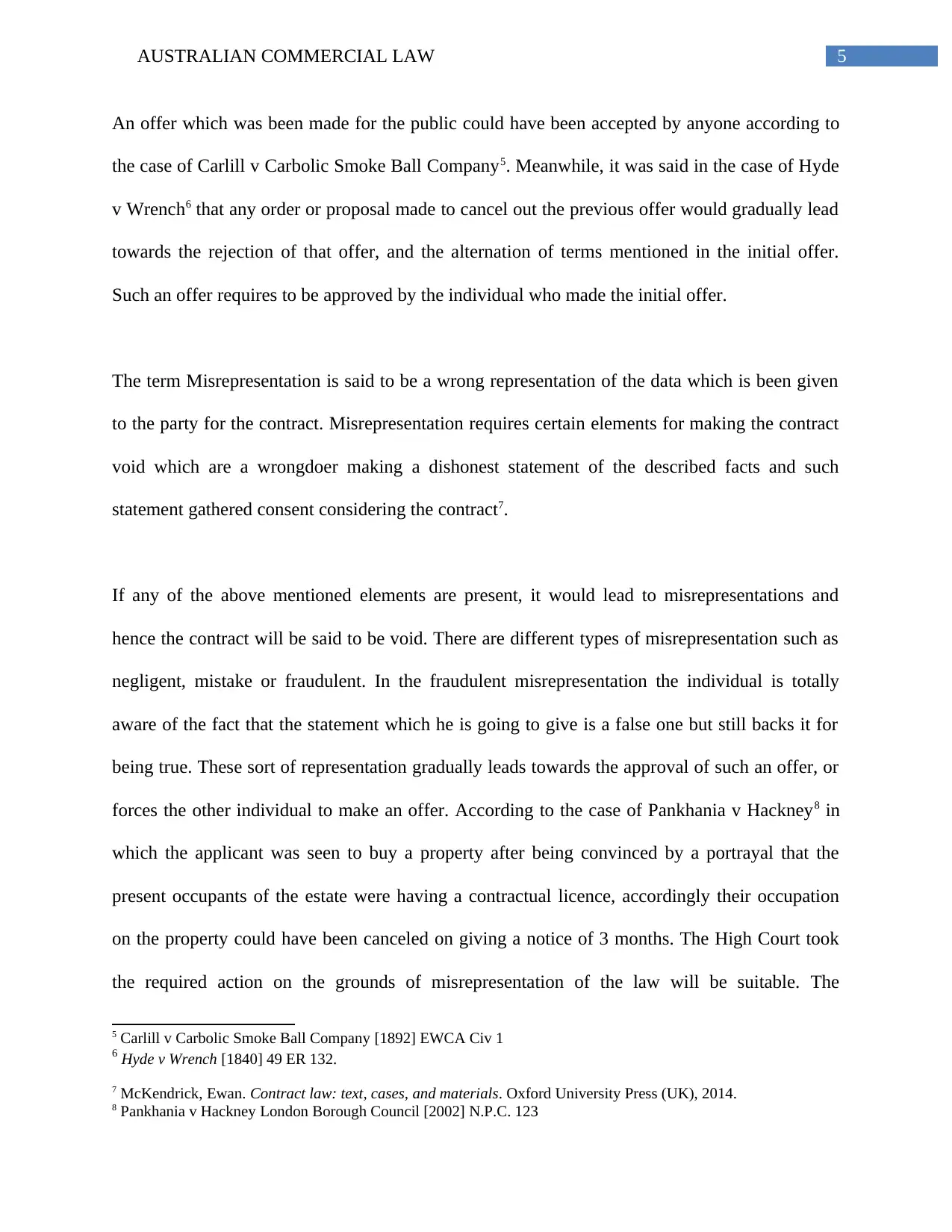
5AUSTRALIAN COMMERCIAL LAW
An offer which was been made for the public could have been accepted by anyone according to
the case of Carlill v Carbolic Smoke Ball Company5. Meanwhile, it was said in the case of Hyde
v Wrench6 that any order or proposal made to cancel out the previous offer would gradually lead
towards the rejection of that offer, and the alternation of terms mentioned in the initial offer.
Such an offer requires to be approved by the individual who made the initial offer.
The term Misrepresentation is said to be a wrong representation of the data which is been given
to the party for the contract. Misrepresentation requires certain elements for making the contract
void which are a wrongdoer making a dishonest statement of the described facts and such
statement gathered consent considering the contract7.
If any of the above mentioned elements are present, it would lead to misrepresentations and
hence the contract will be said to be void. There are different types of misrepresentation such as
negligent, mistake or fraudulent. In the fraudulent misrepresentation the individual is totally
aware of the fact that the statement which he is going to give is a false one but still backs it for
being true. These sort of representation gradually leads towards the approval of such an offer, or
forces the other individual to make an offer. According to the case of Pankhania v Hackney8 in
which the applicant was seen to buy a property after being convinced by a portrayal that the
present occupants of the estate were having a contractual licence, accordingly their occupation
on the property could have been canceled on giving a notice of 3 months. The High Court took
the required action on the grounds of misrepresentation of the law will be suitable. The
5 Carlill v Carbolic Smoke Ball Company [1892] EWCA Civ 1
6 Hyde v Wrench [1840] 49 ER 132.
7 McKendrick, Ewan. Contract law: text, cases, and materials. Oxford University Press (UK), 2014.
8 Pankhania v Hackney London Borough Council [2002] N.P.C. 123
An offer which was been made for the public could have been accepted by anyone according to
the case of Carlill v Carbolic Smoke Ball Company5. Meanwhile, it was said in the case of Hyde
v Wrench6 that any order or proposal made to cancel out the previous offer would gradually lead
towards the rejection of that offer, and the alternation of terms mentioned in the initial offer.
Such an offer requires to be approved by the individual who made the initial offer.
The term Misrepresentation is said to be a wrong representation of the data which is been given
to the party for the contract. Misrepresentation requires certain elements for making the contract
void which are a wrongdoer making a dishonest statement of the described facts and such
statement gathered consent considering the contract7.
If any of the above mentioned elements are present, it would lead to misrepresentations and
hence the contract will be said to be void. There are different types of misrepresentation such as
negligent, mistake or fraudulent. In the fraudulent misrepresentation the individual is totally
aware of the fact that the statement which he is going to give is a false one but still backs it for
being true. These sort of representation gradually leads towards the approval of such an offer, or
forces the other individual to make an offer. According to the case of Pankhania v Hackney8 in
which the applicant was seen to buy a property after being convinced by a portrayal that the
present occupants of the estate were having a contractual licence, accordingly their occupation
on the property could have been canceled on giving a notice of 3 months. The High Court took
the required action on the grounds of misrepresentation of the law will be suitable. The
5 Carlill v Carbolic Smoke Ball Company [1892] EWCA Civ 1
6 Hyde v Wrench [1840] 49 ER 132.
7 McKendrick, Ewan. Contract law: text, cases, and materials. Oxford University Press (UK), 2014.
8 Pankhania v Hackney London Borough Council [2002] N.P.C. 123
⊘ This is a preview!⊘
Do you want full access?
Subscribe today to unlock all pages.

Trusted by 1+ million students worldwide

6AUSTRALIAN COMMERCIAL LAW
applicants action was thus successful. This was also repeated in the case of Car and Universal
Finance v Caldwell9.
There are different remedies in a contract, where acceptance is seen to be achieved by the
fraudulent misrepresentation. There remedies include the Cancellation of the contract as laid
down by Long v Lloyd10 (rescission) and the damages for the injury incurred as laid down by
Doyle v Olby Ltd11.
APPLICATION
According to the mentioned circumstances, Angelo brought up a offer publicly which could have
been accepted by any individual ensuing the judgement of Carlill v Carbolic Smoke Ball
Company. However, a counter offer was made by Barry and therefore the initial offer which was
made, remained cancelled as laid down by Hyde v Wrench. The only phrase which was said to
be diverse was sale price, therefore the moment when Angelo approved the initial terms
mentioned in the offer. However, it was excluding the price.
Therefore, the terms which were declared by Angelo still completed a factor of contract. This
refers to the announcement which stated that there were no present competitors and the statement
which was made in regards to the fund will still be a factor in the contract. Barry got to know
that the revenue per month which was stated in the initial contract was actually much lower and
9 Car and Universal Finance Co Ltd v Caldwell [1965] 1 QB 525
10 Long v Lloyd [1958] 1 WLR 753
11 Doyle v Olby (Ironmongers) Ltd [1969] 2 QB 158
applicants action was thus successful. This was also repeated in the case of Car and Universal
Finance v Caldwell9.
There are different remedies in a contract, where acceptance is seen to be achieved by the
fraudulent misrepresentation. There remedies include the Cancellation of the contract as laid
down by Long v Lloyd10 (rescission) and the damages for the injury incurred as laid down by
Doyle v Olby Ltd11.
APPLICATION
According to the mentioned circumstances, Angelo brought up a offer publicly which could have
been accepted by any individual ensuing the judgement of Carlill v Carbolic Smoke Ball
Company. However, a counter offer was made by Barry and therefore the initial offer which was
made, remained cancelled as laid down by Hyde v Wrench. The only phrase which was said to
be diverse was sale price, therefore the moment when Angelo approved the initial terms
mentioned in the offer. However, it was excluding the price.
Therefore, the terms which were declared by Angelo still completed a factor of contract. This
refers to the announcement which stated that there were no present competitors and the statement
which was made in regards to the fund will still be a factor in the contract. Barry got to know
that the revenue per month which was stated in the initial contract was actually much lower and
9 Car and Universal Finance Co Ltd v Caldwell [1965] 1 QB 525
10 Long v Lloyd [1958] 1 WLR 753
11 Doyle v Olby (Ironmongers) Ltd [1969] 2 QB 158
Paraphrase This Document
Need a fresh take? Get an instant paraphrase of this document with our AI Paraphraser

7AUSTRALIAN COMMERCIAL LAW
he also got to know that there was a shop nearby selling similar grocery products. As being
committed in the sale of fruits and vegetables, it is understood that Angelo was totally aware
regarding the revenue and also that a direct competitor were present in that area. Such
representations persuaded Barry for composing a counter-offer. Therefore, in such circumstances
his agreement must be achieved by misrepresentation.
According to the judgement made in the case of Pankhania v Hackney it is obvious that such a
contract will account to be cancelled. The allegations which were made in regards to the loader
and the van were also said to be fraudulent misrepresentation, and thus it will result to a void
contract.
CONCLUSION
Therefore, Barry was capable for challenging the legitimacy of the contact by the faith in the
promises which were made by Angelo. The contract will be void because of the fraudulent
misrepresentations which were made by Angelo. This contract will be invalidated in accordance
to the judicial pronouncements of the common law. Barry will be capable of getting different
remedies which will be accessible to him like damages or indemnity. Therefore, Angelo is said
to be violating the responsibilities as the seller under the common law.
QUESTION 3
RELEVANT ISSUE
he also got to know that there was a shop nearby selling similar grocery products. As being
committed in the sale of fruits and vegetables, it is understood that Angelo was totally aware
regarding the revenue and also that a direct competitor were present in that area. Such
representations persuaded Barry for composing a counter-offer. Therefore, in such circumstances
his agreement must be achieved by misrepresentation.
According to the judgement made in the case of Pankhania v Hackney it is obvious that such a
contract will account to be cancelled. The allegations which were made in regards to the loader
and the van were also said to be fraudulent misrepresentation, and thus it will result to a void
contract.
CONCLUSION
Therefore, Barry was capable for challenging the legitimacy of the contact by the faith in the
promises which were made by Angelo. The contract will be void because of the fraudulent
misrepresentations which were made by Angelo. This contract will be invalidated in accordance
to the judicial pronouncements of the common law. Barry will be capable of getting different
remedies which will be accessible to him like damages or indemnity. Therefore, Angelo is said
to be violating the responsibilities as the seller under the common law.
QUESTION 3
RELEVANT ISSUE
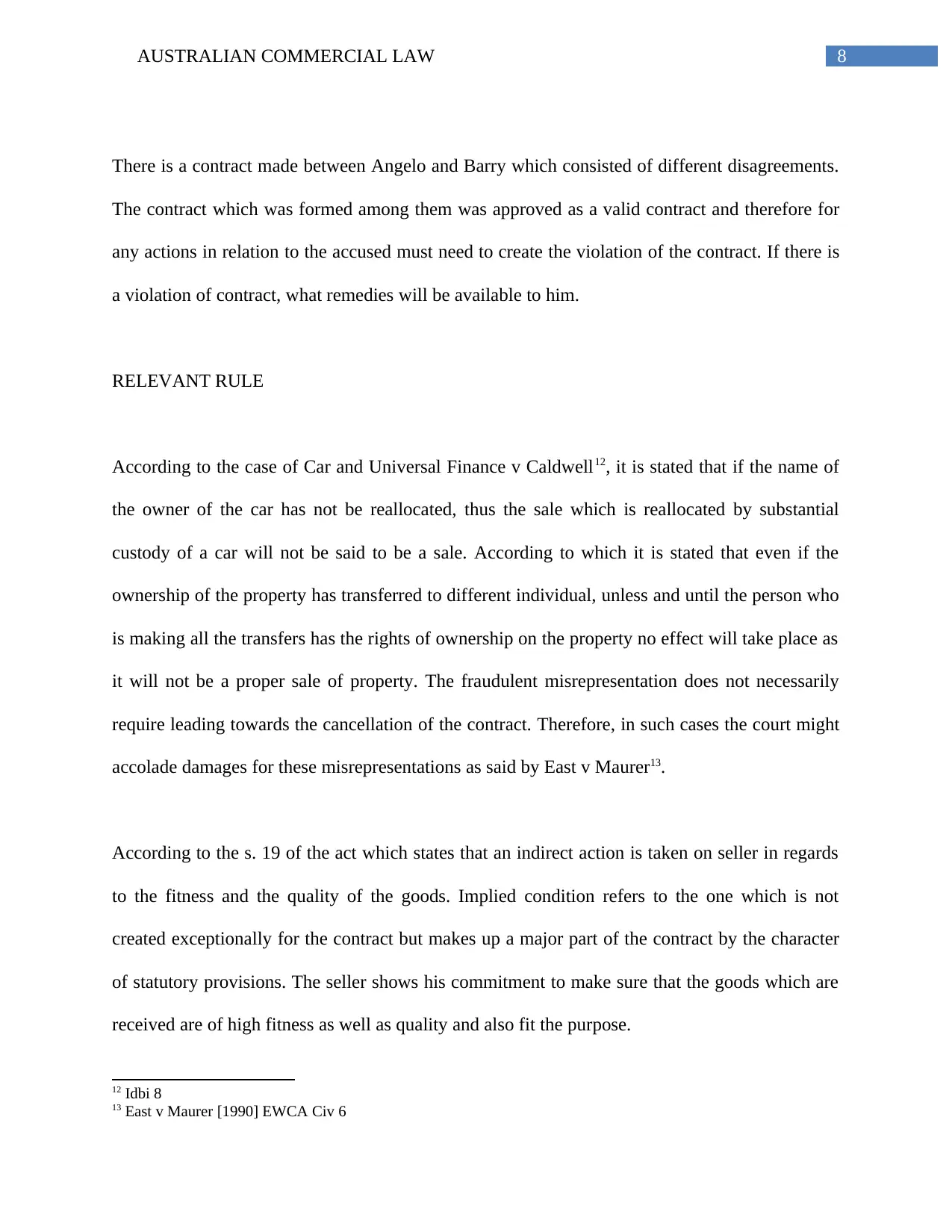
8AUSTRALIAN COMMERCIAL LAW
There is a contract made between Angelo and Barry which consisted of different disagreements.
The contract which was formed among them was approved as a valid contract and therefore for
any actions in relation to the accused must need to create the violation of the contract. If there is
a violation of contract, what remedies will be available to him.
RELEVANT RULE
According to the case of Car and Universal Finance v Caldwell12, it is stated that if the name of
the owner of the car has not be reallocated, thus the sale which is reallocated by substantial
custody of a car will not be said to be a sale. According to which it is stated that even if the
ownership of the property has transferred to different individual, unless and until the person who
is making all the transfers has the rights of ownership on the property no effect will take place as
it will not be a proper sale of property. The fraudulent misrepresentation does not necessarily
require leading towards the cancellation of the contract. Therefore, in such cases the court might
accolade damages for these misrepresentations as said by East v Maurer13.
According to the s. 19 of the act which states that an indirect action is taken on seller in regards
to the fitness and the quality of the goods. Implied condition refers to the one which is not
created exceptionally for the contract but makes up a major part of the contract by the character
of statutory provisions. The seller shows his commitment to make sure that the goods which are
received are of high fitness as well as quality and also fit the purpose.
12 Idbi 8
13 East v Maurer [1990] EWCA Civ 6
There is a contract made between Angelo and Barry which consisted of different disagreements.
The contract which was formed among them was approved as a valid contract and therefore for
any actions in relation to the accused must need to create the violation of the contract. If there is
a violation of contract, what remedies will be available to him.
RELEVANT RULE
According to the case of Car and Universal Finance v Caldwell12, it is stated that if the name of
the owner of the car has not be reallocated, thus the sale which is reallocated by substantial
custody of a car will not be said to be a sale. According to which it is stated that even if the
ownership of the property has transferred to different individual, unless and until the person who
is making all the transfers has the rights of ownership on the property no effect will take place as
it will not be a proper sale of property. The fraudulent misrepresentation does not necessarily
require leading towards the cancellation of the contract. Therefore, in such cases the court might
accolade damages for these misrepresentations as said by East v Maurer13.
According to the s. 19 of the act which states that an indirect action is taken on seller in regards
to the fitness and the quality of the goods. Implied condition refers to the one which is not
created exceptionally for the contract but makes up a major part of the contract by the character
of statutory provisions. The seller shows his commitment to make sure that the goods which are
received are of high fitness as well as quality and also fit the purpose.
12 Idbi 8
13 East v Maurer [1990] EWCA Civ 6
⊘ This is a preview!⊘
Do you want full access?
Subscribe today to unlock all pages.

Trusted by 1+ million students worldwide
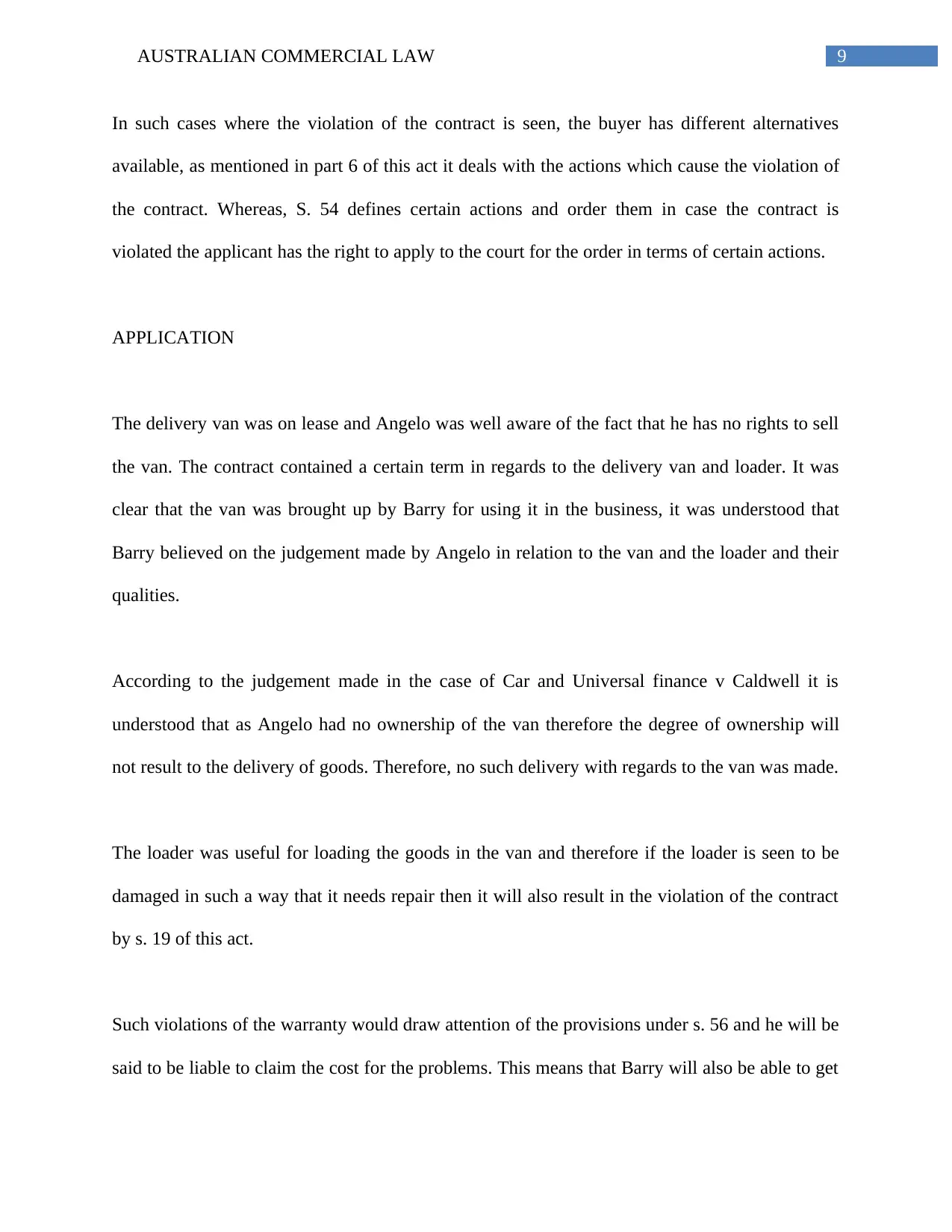
9AUSTRALIAN COMMERCIAL LAW
In such cases where the violation of the contract is seen, the buyer has different alternatives
available, as mentioned in part 6 of this act it deals with the actions which cause the violation of
the contract. Whereas, S. 54 defines certain actions and order them in case the contract is
violated the applicant has the right to apply to the court for the order in terms of certain actions.
APPLICATION
The delivery van was on lease and Angelo was well aware of the fact that he has no rights to sell
the van. The contract contained a certain term in regards to the delivery van and loader. It was
clear that the van was brought up by Barry for using it in the business, it was understood that
Barry believed on the judgement made by Angelo in relation to the van and the loader and their
qualities.
According to the judgement made in the case of Car and Universal finance v Caldwell it is
understood that as Angelo had no ownership of the van therefore the degree of ownership will
not result to the delivery of goods. Therefore, no such delivery with regards to the van was made.
The loader was useful for loading the goods in the van and therefore if the loader is seen to be
damaged in such a way that it needs repair then it will also result in the violation of the contract
by s. 19 of this act.
Such violations of the warranty would draw attention of the provisions under s. 56 and he will be
said to be liable to claim the cost for the problems. This means that Barry will also be able to get
In such cases where the violation of the contract is seen, the buyer has different alternatives
available, as mentioned in part 6 of this act it deals with the actions which cause the violation of
the contract. Whereas, S. 54 defines certain actions and order them in case the contract is
violated the applicant has the right to apply to the court for the order in terms of certain actions.
APPLICATION
The delivery van was on lease and Angelo was well aware of the fact that he has no rights to sell
the van. The contract contained a certain term in regards to the delivery van and loader. It was
clear that the van was brought up by Barry for using it in the business, it was understood that
Barry believed on the judgement made by Angelo in relation to the van and the loader and their
qualities.
According to the judgement made in the case of Car and Universal finance v Caldwell it is
understood that as Angelo had no ownership of the van therefore the degree of ownership will
not result to the delivery of goods. Therefore, no such delivery with regards to the van was made.
The loader was useful for loading the goods in the van and therefore if the loader is seen to be
damaged in such a way that it needs repair then it will also result in the violation of the contract
by s. 19 of this act.
Such violations of the warranty would draw attention of the provisions under s. 56 and he will be
said to be liable to claim the cost for the problems. This means that Barry will also be able to get
Paraphrase This Document
Need a fresh take? Get an instant paraphrase of this document with our AI Paraphraser
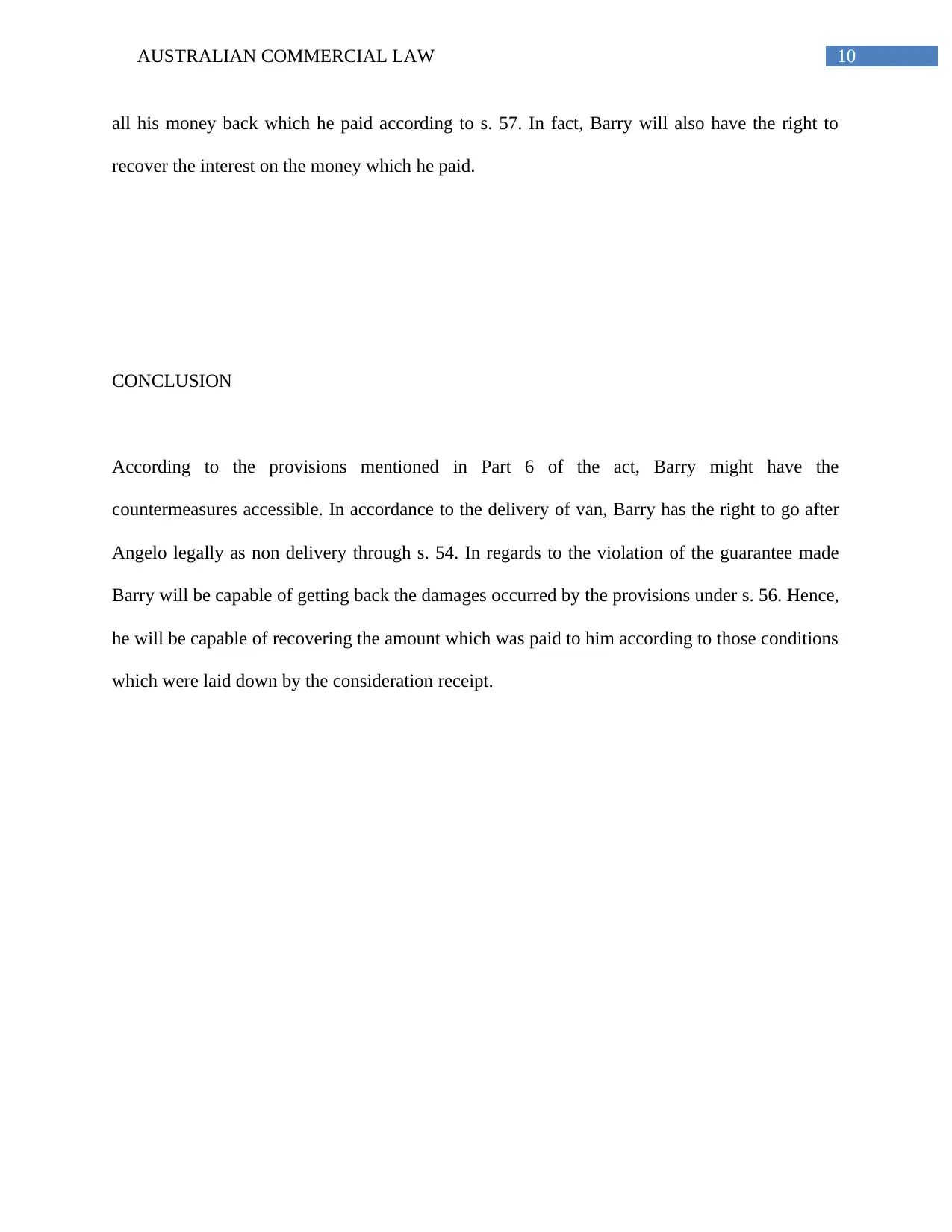
10AUSTRALIAN COMMERCIAL LAW
all his money back which he paid according to s. 57. In fact, Barry will also have the right to
recover the interest on the money which he paid.
CONCLUSION
According to the provisions mentioned in Part 6 of the act, Barry might have the
countermeasures accessible. In accordance to the delivery of van, Barry has the right to go after
Angelo legally as non delivery through s. 54. In regards to the violation of the guarantee made
Barry will be capable of getting back the damages occurred by the provisions under s. 56. Hence,
he will be capable of recovering the amount which was paid to him according to those conditions
which were laid down by the consideration receipt.
all his money back which he paid according to s. 57. In fact, Barry will also have the right to
recover the interest on the money which he paid.
CONCLUSION
According to the provisions mentioned in Part 6 of the act, Barry might have the
countermeasures accessible. In accordance to the delivery of van, Barry has the right to go after
Angelo legally as non delivery through s. 54. In regards to the violation of the guarantee made
Barry will be capable of getting back the damages occurred by the provisions under s. 56. Hence,
he will be capable of recovering the amount which was paid to him according to those conditions
which were laid down by the consideration receipt.
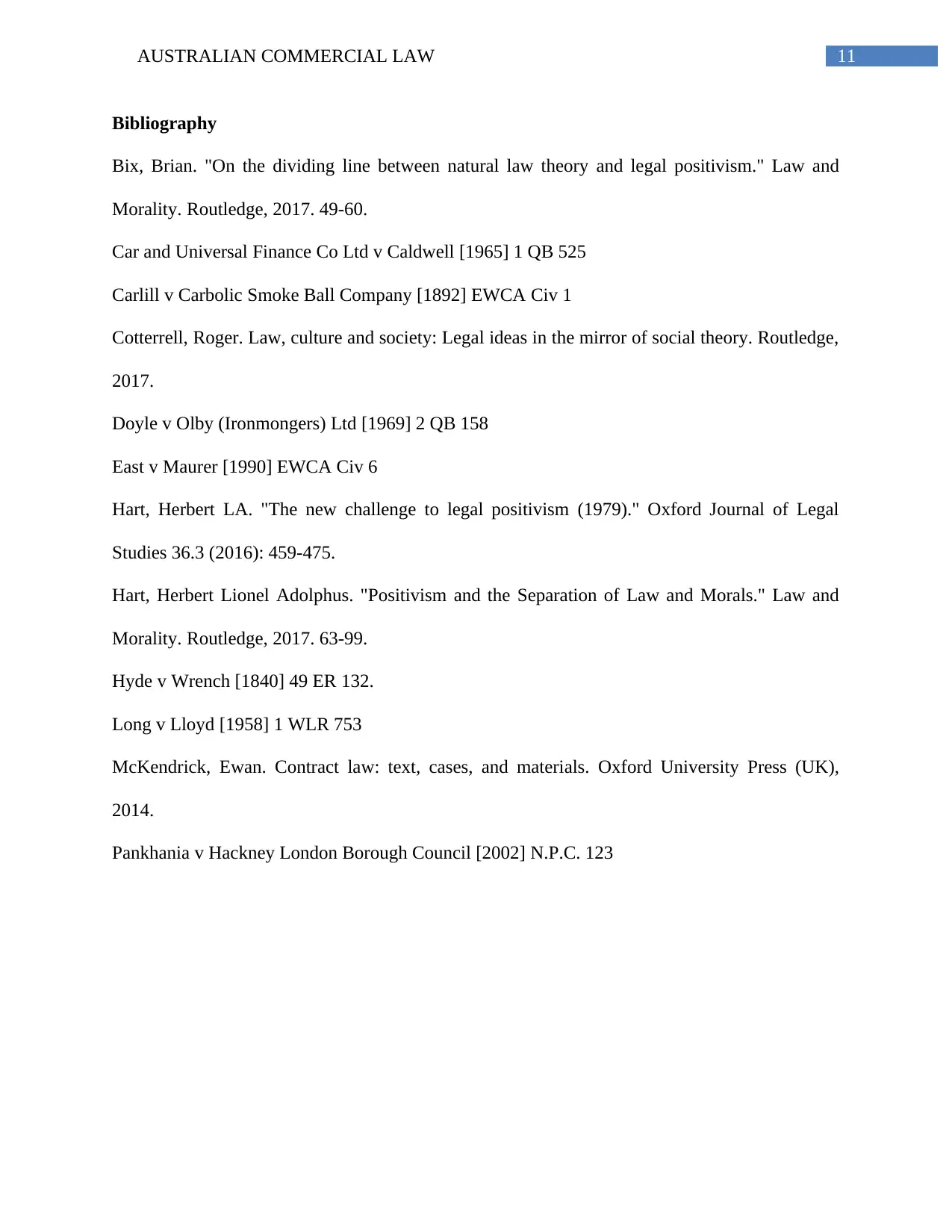
11AUSTRALIAN COMMERCIAL LAW
Bibliography
Bix, Brian. "On the dividing line between natural law theory and legal positivism." Law and
Morality. Routledge, 2017. 49-60.
Car and Universal Finance Co Ltd v Caldwell [1965] 1 QB 525
Carlill v Carbolic Smoke Ball Company [1892] EWCA Civ 1
Cotterrell, Roger. Law, culture and society: Legal ideas in the mirror of social theory. Routledge,
2017.
Doyle v Olby (Ironmongers) Ltd [1969] 2 QB 158
East v Maurer [1990] EWCA Civ 6
Hart, Herbert LA. "The new challenge to legal positivism (1979)." Oxford Journal of Legal
Studies 36.3 (2016): 459-475.
Hart, Herbert Lionel Adolphus. "Positivism and the Separation of Law and Morals." Law and
Morality. Routledge, 2017. 63-99.
Hyde v Wrench [1840] 49 ER 132.
Long v Lloyd [1958] 1 WLR 753
McKendrick, Ewan. Contract law: text, cases, and materials. Oxford University Press (UK),
2014.
Pankhania v Hackney London Borough Council [2002] N.P.C. 123
Bibliography
Bix, Brian. "On the dividing line between natural law theory and legal positivism." Law and
Morality. Routledge, 2017. 49-60.
Car and Universal Finance Co Ltd v Caldwell [1965] 1 QB 525
Carlill v Carbolic Smoke Ball Company [1892] EWCA Civ 1
Cotterrell, Roger. Law, culture and society: Legal ideas in the mirror of social theory. Routledge,
2017.
Doyle v Olby (Ironmongers) Ltd [1969] 2 QB 158
East v Maurer [1990] EWCA Civ 6
Hart, Herbert LA. "The new challenge to legal positivism (1979)." Oxford Journal of Legal
Studies 36.3 (2016): 459-475.
Hart, Herbert Lionel Adolphus. "Positivism and the Separation of Law and Morals." Law and
Morality. Routledge, 2017. 63-99.
Hyde v Wrench [1840] 49 ER 132.
Long v Lloyd [1958] 1 WLR 753
McKendrick, Ewan. Contract law: text, cases, and materials. Oxford University Press (UK),
2014.
Pankhania v Hackney London Borough Council [2002] N.P.C. 123
⊘ This is a preview!⊘
Do you want full access?
Subscribe today to unlock all pages.

Trusted by 1+ million students worldwide
1 out of 12
Related Documents
Your All-in-One AI-Powered Toolkit for Academic Success.
+13062052269
info@desklib.com
Available 24*7 on WhatsApp / Email
![[object Object]](/_next/static/media/star-bottom.7253800d.svg)
Unlock your academic potential
Copyright © 2020–2025 A2Z Services. All Rights Reserved. Developed and managed by ZUCOL.





